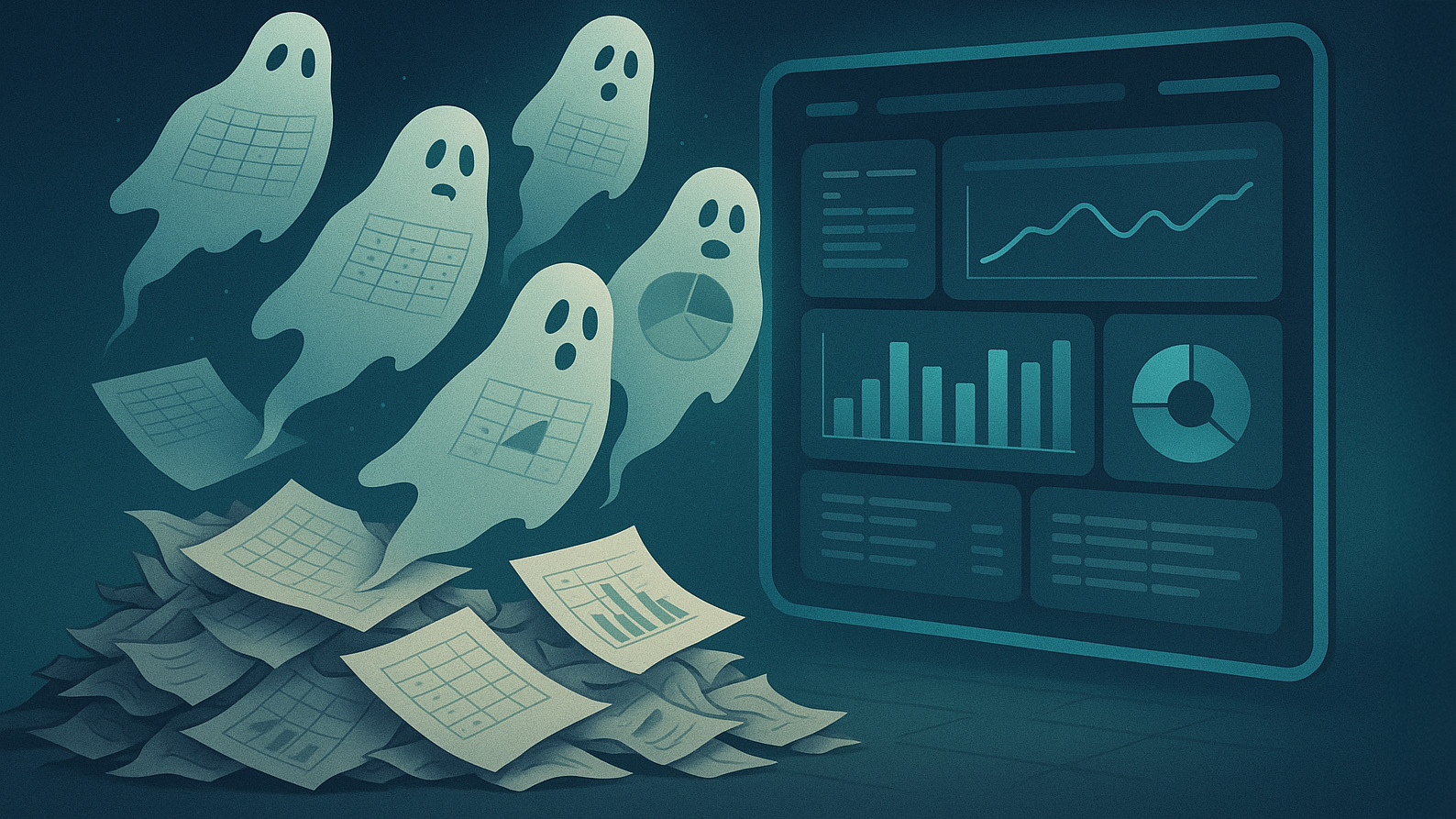Once upon a spreadsheet, someone thought they were being organised. Rows, columns, colour-coded tabs, a forest of formulas, and a deep, misplaced belief that Excel could scale. It was all going so well until the emails started multiplying like digital rabbits. Someone missed a version update, another attached the wrong file, and by the time the team realised the numbers didn’t add up, the client had already sent a polite but furious note. Welcome to the world of operational chaos disguised as order.
Every company that’s grown beyond its founder’s to-do list has passed through this awkward adolescence: the Spreadsheet Era. It starts innocently enough. A sales tracker here, an inventory log there, a few clever pivot tables to impress the board. But soon the whole business is hanging by the fragile logic of one Excel wizard whose departure could bring the enterprise to its knees. When that person goes on holiday, the rest of the team performs a kind of digital seance to summon their knowledge. “Does anyone know which version is final-final?” “Why does the formula say ‘#REF!’ again?” These are the modern cries of operational despair.
The problem isn’t spreadsheets or email chains per se. They’re brilliant tools — until they start running the business instead of supporting it. Growth exposes the fault lines. Suddenly you’ve got ten departments, three time zones, and a customer base that expects 24/7 service. The old patchwork collapses under its own weight. Processes that once felt nimble now feel medieval. Everyone spends more time looking for information than using it. Accountability becomes a game of digital hide-and-seek. By the time leadership realises what’s happening, it’s too late: the spreadsheets have staged a coup.
That’s when the phrase digital transformation in operations starts appearing in board meetings. It sounds grand, maybe even intimidating, but it really means something simple: stop fighting fires manually and start connecting the dots automatically. It’s not about replacing people with machines; it’s about freeing people from drudgery so they can do the work that actually moves the company forward.
Let’s be honest: every business thinks it’s unique until it tries to automate something. Then you realise you’ve been reinventing the same wheels as everyone else. Quoting, invoicing, onboarding, approvals, reporting — these processes are not your secret sauce. They’re plumbing. Necessary, yes, but hardly a differentiator. Yet for years, companies have been pouring human talent into patching leaks in that plumbing. Digital transformation simply replaces those leaky pipes with a proper system — one that doesn’t require you to scroll through a 12-MB attachment just to see who approved what.
Enter ERP, CRM, and workflow automation — the holy trinity of modern operations. An ERP system ties together finance, supply chain, procurement, and HR into one coherent flow. A CRM keeps customer data where it belongs — visible, trackable, and actually useful. Workflow automation, meanwhile, acts like a digital conductor, making sure each process plays its part in tune and on time. Together, they do what spreadsheets never could: create a single version of truth that everyone can see without panic attacks or late-night email threads titled “URGENT: updated.xlsx (this one for real).”
It’s easy to roll your eyes at buzzwords like “digital transformation.” They sound like the kind of corporate mantra consultants use to justify a year-long project and a six-figure invoice. But strip away the jargon, and it’s about something deeply practical: operational sanity. It’s about knowing that when you click a button, the system doesn’t implode. It’s about teams collaborating in real time instead of tripping over each other’s data. It’s about creating a backbone strong enough to carry the company’s ambitions.
Here’s the irony, though. Many leaders delay digital transformation precisely because they’re “too busy.” They’re firefighting, not realising that the fires come from the same broken systems they’re refusing to fix. It’s like saying you don’t have time to service your car because you’re late for work — only to end up stranded on the motorway. Every week spent clinging to spreadsheets is another week lost to inefficiency, frustration, and missed opportunity.
Of course, transformation isn’t just about buying software. The technology is the easy part. The real work lies in rethinking how things should flow. A shiny new system won’t magically fix a messy process — it’ll just automate the mess faster. That’s why successful transformations start with honest diagnosis: what’s actually broken, who’s stuck maintaining it, and how it could work better. Then comes the people part: getting everyone to trust the new system. Because no matter how advanced the tech, nothing stalls progress faster than a team secretly keeping its old Excel files “just in case.”
Cultural change is the unspoken side of digital transformation. You can train people to use new tools, but you can’t buy belief. That has to be built — slowly, deliberately, and with transparency. It means showing teams how automation isn’t a threat but a relief. It means proving that systems aren’t there to micromanage them but to remove friction. The goal is empowerment, not surveillance. Once people see that the machine makes their day smoother instead of harder, adoption follows naturally.
Take the finance team, for example. Before transformation, they might spend days reconciling invoices, chasing receipts, and manually updating ledgers. After automation, those tasks run in the background. Data flows directly from purchase orders to accounting without the usual copy-paste nightmares. Suddenly, the finance team has time to analyse instead of chase — to add insight rather than just report history. That’s where real value lives.
Or consider customer service. In the old world, one agent might spend half their day trawling through emails to piece together a customer’s story. In the transformed world, the CRM tells that story instantly — every purchase, every complaint, every compliment in one place. The agent isn’t just reacting; they’re anticipating. And that shift, from reactive to proactive, is the quiet revolution digital transformation delivers.
There’s also the beautiful side effect of visibility. Once data lives in one place, patterns emerge. You start seeing where things slow down, where bottlenecks hide, and where opportunities sparkle. Leaders can make decisions based on evidence rather than hunches. It’s less drama, more direction. And while it might sound boring compared to the wild west of spreadsheets, stability has its own kind of thrill — especially when it fuels faster growth and happier customers.
Still, digital transformation doesn’t mean perfection. Systems fail, integrations hiccup, and change always tests patience. But the difference is resilience. When your operations run on connected platforms, recovery is faster and lessons stick. The company learns to evolve instead of patch. The mindset shifts from “Let’s fix this spreadsheet” to “Let’s design this properly.” That’s when you know you’ve crossed the invisible line between reactive and strategic.
In a world where competition moves at algorithmic speed, sticking with manual tools isn’t thrift — it’s self-sabotage. Customers don’t care if your process is complicated; they care if it’s slow. Employees don’t care about the logo on the software; they care about whether it saves them from another all-nighter. And investors, well, they care about whether your operations can scale without falling apart. Digital transformation in operations sits at the heart of all three. It’s the quiet infrastructure behind every headline success story.
One day, someone will open your systems and find everything connected: finance talking to sales, operations talking to marketing, customers actually getting what they ordered when they expected it. No one will be emailing “just checking in” or asking “which version should I use.” And in that moment, you’ll realise something remarkable — the company finally stopped running on panic and started running on purpose.
Because digital transformation isn’t about technology. It’s about reclaiming time, trust, and sanity. The spreadsheets served their purpose once. Now it’s time to let them retire gracefully — maybe even frame the last one as a reminder of how far you’ve come.

